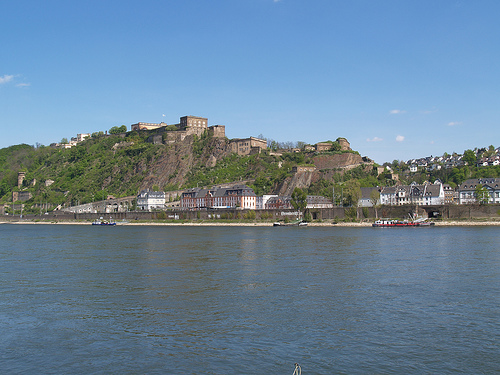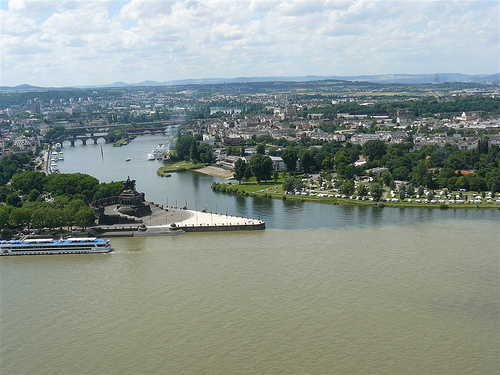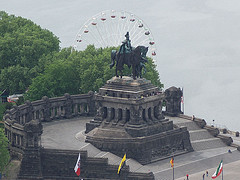

Burg Ehrenbreitstein is a defensive fortification that stand today on the hill on the Eastern side opposite of city of Koblenz at the confluence of Rhine and Moselle rivers. By European standards it is a fairly recent structure build between 1817 and 1832 to defend vulnerable Rhine region against French attacks. Despite its formidable size it was never used in a battle.
Location: Rhineland
Tel. (0261) 974 2450
(0261)974 2450
Hours: 10 am - 5 pm
Early fortification on this strategic location appeared as early 1000 BC. In the 11th century AD Ehrenbert erected a castle on this place. Thus it got its name which means in German “rock of Ehrenbert”. Archbishops of Trier expanded the castle and used it to defend the Holy Tunic, that was worn according to a legend by Jesus Christ at the time of his crucifixion. However the Church did not permit neither Germans nor French to occupy or use this territory during conflicts between each other. In 1799 after a year long siege starvation forced the defenders to abandon fort and hand it over to French Revolutionary army. Most of citadel was destroyed in 1801. After defeat of Napoleon, Prussia started construction new construction in 1817 and current castle served as a military fortification until 1890.
Today this extensive structure houses two restaurants, the Landes museum and a youth hostel.
Monument to the dead German soldiers who fought and died for their country in the World War I. Judging by the flowers the monument holds important significance for the Germans. Please respect the memory of the dead.
Rhine and Moselle rivers have distinct coloration. You can see a border between these two rivers.
The Ehrenbreitstein Fortress is located on a 180 m high mountain spur of the same name, whose rugged rock faces end in the Koblenz district of Ehrenbreitstein in the Rhine Valley. As a result, only the ridge of the hill towards the plateau in the north-east had to be defended particularly strongly. In the 19th century, the Prussian fortress of Ehrenbreitstein was considered impregnable, on the one hand because of its location on the mountain of the same name and on the other hand because the enemy could always be attacked from all sides through the other fortresses and forts in the fortress network. The Ehrenbreitstein is bordered on three sides – in the south, in the east and in the west towards the Rhine – by high steep slopes. The fortress is accessible from the banks of the Rhine, past the Helfenstein Vorwerk, and from the mountain plateau in the north. Ideal for defense purposes, the mountain spur has been used for military installations since the earliest times.
Prehistory
The settlement of the Ehrenbreitstein dates back to around
4000 BC. proven. During excavations in the spring of 2005, the remains
of a 10th century B.C. piling ditch were uncovered under the Great
Traverse (more precisely: under the eastern cupola hall). found. It was
part of a Bronze Age fortification that was located on the southern part
of the mountain spur. At a point only about 30 meters wide, the
palisade, which was reinforced from behind with earth, secured the
southern part of the mountain spur against the only access possibility
in the north. During an archaeological excavation in 2003, the remains
of a Celtic noble seat were discovered under the flag tower. Archery
projectiles, vessels and coins have been found from Roman times, which
indicate that the rock was used by the Romans. From about 250 to 450,
there was a late Roman burgus on the southern rocky spur to protect the
Moselle estuary, the Roman roads and the nearby Limes. Ceramic finds
from the Carolingian period suggest a medieval fortification in the 8th
or 9th century.
Ehrenbreitstein Castle
Around the year 1000,
there was probably Ehrenbreitstein Castle, built by Erembert or
Ehrenbrecht from the Lahngau-Konradin count family. According to a first
documented mention, it became the property of the Prince Bishops of
Trier around 1020 after it was bought by Archbishop Poppo von Babenberg.
The castle was the bridgehead for the possessions of the Electorate of
Trier on the right bank of the Rhine and was considered its most secure
castle. Important sanctuaries of the country were kept here in uncertain
times, the head of St. Matthias (diocese patron) from 1380 to 1422 and
the holy tunic with a few short interruptions from 1657 to 1794.
The castle was enlarged around 1160 by Archbishop Hillin of Fallmania. A
neck ditch built at this time, the so-called Hellengraben, could be
detected under the Great Traverse. He renovated the archbishop's houses,
deepened the neck moat, built the pentagonal keep behind it and had a
cistern built. Further expansions and conversions followed, in
particular the expansion of the castle into a fortress from the 16th
century. Occasionally the name Hermannstein Fortress appears in old
graphics. It is obviously based on errors of the graphic designers.
To the south, Helfenstein Castle was built on a mountain spur around
1160, which was inhabited by the von Helfenstein family until the 14th
century and then fell into disrepair. With the construction of the
Prussian fortress, the castle ruins were built over by Fort Helfenstein.
Extension to the electoral fortress of Trier
Archbishop Richard
von Greiffenklau zu Vollrads began to expand the castle into a fortress
in the early 16th century due to advancing war technology. The complex
was provided with a moat and bastions on the north side. The
establishment of the armory also goes back to his initiative.
Greiffenklau also had the first cannons cast for the new fortress. The
largest of these cannons is the Siege Cannon Greif, which weighs nine
tons and is 4.66 meters long, and was cast in 1524 by Master Simon from
Frankfurt am Main. After the French conquered the Ehrenbreitstein in
1799, the cannon was brought to France. In 1940, after the conquest of
France, she came back briefly, but was taken back to Paris in 1946. In
1984, during the tenure of French President François Mitterrand, who
signed a corresponding contract with Federal Chancellor Helmut Kohl on
the Ehrenbreitstein, it returned to the fortress as a permanent loan.
Around 1600, a bastion was built in front of the fortress under the
direction of the fortress builder Johann (II.) von Pasqualini, a
grandson of Alessandro Pasqualini. Beneath and protected by it, Elector
and Archbishop Philipp Christoph von Sötern had Philippsburg Palace
built between 1626 and 1629 and in 1629 moved his residence here from
Trier, which had meanwhile become unsafe. During the Thirty Years' War,
Ehrenbreitstein Fortress changed hands twice after the Archbishop had
first granted France the right of occupation in 1631 and French troops
occupied the fortress on June 5, 1632. Three weeks later the city of
Koblenz capitulated and was also occupied. In October 1635, the French
entered the war after an alliance with Duke Bernhard of Saxe-Weimar.
After the archbishop had been captured by imperial troops in 1635 and
Trier had been conquered, they also liberated Koblenz in May 1636.
However, the French continued to control the fortress as a bridgehead on
the right bank of the Rhine. In order to get the Ehrenbreitstein handed
over, Johann von Werth, who had already won more than 30 victories
against the French and was therefore known as the French Terror, set out
from Cologne against the fortress. After a siege in which he managed to
starve the French troops, the fortress surrendered on June 27, 1637 and
remained under imperial occupation until the end of the war.
The
Ehrenbreitstein fell back to Electoral Trier in 1650. Archbishops Karl
Kaspar von der Leyen and Johann Hugo von Orsbeck had the fortress
expanded further in the 17th century. The latter had the Hellengraben
filled with rubble after the shelling of the city of Koblenz in 1688
during the Palatinate War of Succession and a multi-storey
representative residential building built above it. In 1729, Archbishop
Franz Georg von Schönborn began further expanding the complex into a
baroque fortress. He also had the new Schönborn works laid before the
two ramparts in the north. Balthasar Neumann planned this wall with a
ditch, covered path and counter mine system around 1730. Additional
batteries were set up on the Rhine side and on the Helfenstein.
On October 23, 1794, French revolutionary troops conquered the city of
Koblenz during the First Coalition War and besieged the fortress four
times from 1795. On January 27, 1799, after a blockade of almost a year,
it was handed over because the crew hardly had any food left. The Treaty
of Lunéville in 1801 forced the French to give up the right bank of the
Rhine, including the Ehrenbreitstein. In order not to leave them to the
enemy, they blew up the baroque fortress according to plan. The
Philippsburg Palace below was so badly affected by the blast that it had
to be demolished. In 1803, the ruins of the fortress passed to the
Principality of Nassau-Weilburg (later the Duchy of Nassau) for a short
time by the Reichsdeputationshauptschluss.
New construction as a
Prussian fortress
After the Congress of Vienna in 1814/1815, the
territory of the Electoral State of Trier passed to the Kingdom of
Prussia as part of the Rhine Province. On March 11, 1815, King Friedrich
Wilhelm III. the "Order for the Refortification of the City of Coblenz
and the Ehrenbreitstein Fortress". In the years that followed, the
Koblenz Fortress was built, one of the most extensive fortification
systems in Europe, built according to what was then the most modern
knowledge, the "New Prussian fortification style".
The three main
fortifications of the Koblenz Fortress were to be given the names of the
three monarchs of the countries involved in the wars of liberation,
Prussia, Austria and Russia, who had joined together to form the Holy
Alliance. Apparently there were brief considerations about naming the
Ehrenbreitstein Fortress after the Prussian King Feste Friedrich
Wilhelm, but the historical name Ehrenbreitstein was ultimately chosen.
The Prussian military and leading engineering officers General of
the Infantry Gustav von Rauch, General Inspector of the Prussian
Fortresses, Major General Ernst Ludwig von Aster, Inspector of the
Rhenish Fortresses, Major General Claudius Franz Le Bauld de Nans and
Major General erected the remains of the destroyed Electoral Trier
fortress on the Ehrenbreitstein Gotthilf Benjamin Keibel built a
sprawling citadel that still dominates the cityscape today.
One
of the largest military bulwarks on the Rhine was built in Koblenz, of
which only the Ehrenbreitstein is almost completely preserved today. The
construction of the new Ehrenbreitstein Fortress lasted from 1817 to
1828. However, it was only part of the large-scale Prussian fortress of
Koblenz and Ehrenbreitstein, which was only completed in 1834. The
largest fortress built at the time, the fortress of Emperor Alexander,
stood on the ridge above the former monastery, the Karthause. After the
completion of the Ehrenbreitstein Fortress, the Nöllenkopf works and the
Pleitenberg works were built upstream for reinforcement.
The
following engineering officers were involved in the construction of the
fortress under the direction of Carl Schnitzler in the construction
phase up to around 1832:
Julius Theodor Berggold (* May 7, 1798 in
Dresden; † July 12, 1842 in Münster), joined the Prussian engineering
corps in 1816 as a Saxon tranchee sergeant, 1828 in Koblenz (Nöllenkopf
and Pleitenberg plants, Ober-Ehrenbreitstein), last captain and garrison
construction director in Munster.
August Donant
Carl (Johann Georg
David) Moser (* August 10, 1786 in Berlin; † January 26, 1842 in
Neisse), 1813 second lieutenant in the Prussian engineering corps,
1816-1820 in Koblenz, finally major and field engineer in Neisse.
Johann Ludwig Piepersberg (born May 6, 1796 in Emden; † April 21, 1858
in Berlin), joined the Prussian engineering corps in 1820, 1831–1832 in
Koblenz, lastly captain and planning chamber inspector in Berlin.
Baron von Rosenberg († January 7, 1849 in Ziegenhals in the district of
Neisse), 1813 second lieutenant in the Prussian engineering corps,
1817–1822 in Koblenz (Ober- and Nieder-Ehrenbreitstein), finally captain
and field engineer in Neisse, 1839 as major adopted.
Friedrich
Sterzel
Wilhelm Theodor Ludwig von Winterfeld
time of the
world wars
After 1919 the Ehrenbreitstein was to be razed in
accordance with the provisions of the Versailles Treaty. However, the
Interallied Military Control Commission (IMKK) in Berlin refrained from
doing so on February 25, 1922, after the American General Henry Tureman
Allen on the Allied side and Lieutenant Colonel a. D. Eduard Hüger,
until 1924 head of the Koblenz Defortification Office, had campaigned
vehemently for its preservation, referring to the cultural value of the
fortress. First, American troops occupied the Ehrenbreitstein in 1918.
They were followed by French soldiers in the years 1923 to 1929. On
February 25, 1922, the I.M.K.K. officially the preservation of
Ehrenbreitstein Fortress.
In the course of the remilitarization
of the Rhineland, German soldiers moved back to the Ehrenbreitstein in
1936. From autumn 1936 to June 1939, an anti-tank unit, the 14th company
of the 80th Infantry Regiment, used the Landbastion and Hohe Ostfront as
barracks. During the Second World War, art objects and archives from
Koblenz, Cologne and Wuppertal were stored in the casemates. However,
accidental bomb hits showed that the casemates did not offer adequate
protection against bombs. As part of the air defense of Koblenz, there
were three anti-aircraft guns on the fortress from 1941 at the latest
(roofs of the Rhine Bastion, Contregarde Links and the Lower Eastern
Front). In 1943, an air raid shelter was built in the rock under the
fortress, more precisely under the Helfenstein. Although the city of
Koblenz was 87% destroyed by air raids, the fortress suffered hardly any
damage (only in the area of the long line and the flag tower). On
December 19, 1944, the first railway wagons with archive materials left
the fortress. A total of twelve wagons were gradually loaded with
valuable items from the state archives in Koblenz and Düsseldorf and
sent to Salzdetfurth. On March 27, 1945, US soldiers occupied the
fortress. In mid-1945, when the French occupation zone was created,
French soldiers relieved it.
strategic importance
The
Ehrenbreitstein formed the main bulwark of Koblenz Fortress, which had a
total circumference of 14 km. This made Koblenz Fortress, after its
expansion in Prussian times, one of the largest fortifications in
Europe. It never attained the strategic importance of Gibraltar or the
fortress of Luxembourg ("Gibraltar of the North" razed between 1867 and
1883); However, like Gibraltar itself, Koblenz Fortress was considered
impregnable, at least at the time of its completion. In terms of the
extent of the fortifications, the Koblenz Fortress was roughly on a par
with the Paris Fortress and the Cologne Fortress.
The
Ehrenbreitstein was optimized for defense against all weapons and types
of attacks known at the time. Among other things, the firing ranges of
the firearms of the time determined the dimensions of the system. In the
event of war, 1,500 soldiers with 80 guns were to defend the
Ehrenbreitstein. The fortress was fortified a total of eight times due
to foreign policy events and revolutions. H. prepared for defence, but
was never attacked apart from eight World War I air raids on Koblenz
beginning in October 1917.
In contrast to the former Trier
electoral fortress, the facility was not manned by mercenaries, but
exclusively by professional soldiers and conscripts. After the army
reform of 1808, the stay was even relatively comfortable. For example,
each soldier had his own bed, and the newly built casemates (rooms
protected against cannon fire and bombs), which also served as
accommodation, were equipped with stove heating and windows.
The
entire Koblenz Fortress was in active service until 1890, but from 1886
it was classified as a fortress of minor importance. From 1890 onwards,
due to advancing war technology, the fortifications on the left bank of
the Rhine began to be abandoned. The fortifications on the right bank of
the Rhine with the Ehrenbreitstein remained operational until the end of
the First World War, with the exception of the Bienhornschanze. The last
garrison of the Ehrenbreitstein was the III. Battalion of the Infantry
Regiment "von Goeben" (2nd Rhenish) No. 28 and the 2nd Battalion of the
Schleswig-Holstein Foot Artillery Regiment No. 9, in the First World War
then above all the replacement formations of the latter regiment.

Monument: Just below the castle this is monument to Emperor Wilhelm I erected in 1897 on a Deutsches Eck.

Quote
...this pulpit, I see, is a self-containing stronghold --a lofty Ehrenbreitstein... Herman Melville, Moby Dick
Here Ehrenbreitstein, with her shattered wall
Black with the miner's blast, upon her height
Yet shows of what she was, when shell and ball
Rebounding idly on her strength did light;
A tower of victory! from whence the flight
Of baffled foes was watch'd along the plain:
But Peace destroy'd what War could never blight,
And laid those proud roofs bare to Summer's rain--
On which the iron shower for years had pour'd in vain.
(Lord
Byron,Childe
Harold's Pilgrimage Canto III, v.58)